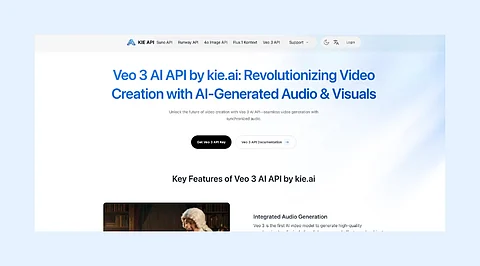

The landscape of video production is undergoing a radical transformation. Tasks that once demanded complex equipment, production teams, and time-intensive editing can now be performed through AI—with unprecedented speed and precision.
At the heart of this technological leap is Google’s Veo 3 API, an advanced model that turns simple prompts into richly detailed, cinematic video output. Whether for developers building applications or content teams scaling visual storytelling, the Veo 3 API represents a paradigm shift in how videos are conceived and created.
Yet despite its groundbreaking capabilities, the Veo 3 API remains out of reach for many due to high usage costs and regional access restrictions. That’s where Kie.ai steps in—providing streamlined, cost-effective Veo 3 API access with developer-first tools and global availability.
Google’s Veo 3 represents a groundbreaking shift in AI video generation—most notably through its ability to produce not just visuals, but fully synchronized audio that matches on-screen motion with uncanny precision. Dialogue aligns with lip movements. Sound effects are timed to the environment. Even ambient audio shifts dynamically with the scene. This level of audiovisual coherence, especially in mouth shape synchronization, dramatically closes the gap between human-directed filmmaking and machine-generated content.
Beyond audio, Veo 3 delivers remarkable consistency in character appearance, lighting, and motion across scenes. It understands spatial depth, camera transitions, and cinematic framing—producing high-resolution clips at 24 to 30 frames per second with either fast or quality rendering modes. For creators and developers alike, the Veo 3 API makes it possible to generate professional-grade video from simple prompts—reliably, rapidly, and without the traditional production overhead.
Veo 3 API’s most impressive innovation lies in its ability to generate speech that is not only contextually appropriate—but also visually synchronized with the character’s mouth movements. This level of audio-visual coherence allows characters to appear as if they are truly speaking, with natural lip-sync accuracy that eliminates the need for separate voice dubbing or manual audio alignment. In addition to spoken dialogue, the model generates ambient sounds, music, and effects that respond organically to each scene’s mood and action.
Veo 3 handles complex visual dynamics such as camera pans, zooms, and time-of-day lighting transitions with a level of sophistication typically reserved for human-directed cinematography. Whether it’s a dramatic sweep across a landscape or a close-up of a moving subject, the model applies motion physics and light behavior that create immersive, film-like results. This makes the Veo 3 API suitable for everything from moody storytelling to fast-paced commercial visuals.
A persistent challenge in generative video has been keeping characters and settings consistent across multiple clips. Veo 3 API solves this through advanced prompt referencing and input conditioning, allowing creators to maintain visual continuity—whether a character is reappearing in a new setting or an object needs to persist across scenes. This consistency is essential for narrative cohesion and professional-grade production workflows.
The Veo 3 API supports high-resolution generation up to 1080p , frame rates of 24–30 fps, and durations up to 8 seconds per clip—with multi-clip chaining possible for longer sequences. Users can choose between “Quality” mode for polished cinematic results or “Fast” mode for rapid prototyping and iteration. This balance of fidelity and flexibility makes it a powerful tool for both quick content creation and large-scale production pipelines.
As generative video technology evolves, access to advanced models like the Veo 3 API raises an important question: how do you balance computational intensity with practical affordability?
Google’s own Vertex AI platform provides official access to Veo 3 API, but charges approximately $6 per 8-second clip in quality mode, with limited options for real-time or iterative generation. Other platforms like Replicate and Fal.ai offer similar access models at comparable price points, generally ranging from $5.80 to $6.30 per render. These services often appeal to enterprise users or research teams, but may prove cost-prohibitive for independent creators or startups.
In contrast, new-generation providers such as Kie.ai are working to democratize access by optimizing the backend pipeline and offering alternative usage modes. With pricing as low as $0.40 for Fast mode and $2 for full-quality output, Kie.ai makes Veo 3 API more viable for iterative testing, content prototyping, and scaled production. This flexibility allows teams to align output quality with purpose—using fast, lower-cost runs to explore ideas, and higher-quality renders for final assets—without overcommitting budget.
As Veo 3 API becomes more widely adopted, understanding these pricing differences will be key for teams aiming to integrate AI video generation into their workflows. It’s not just about technical performance, but also about choosing an access model that supports creative freedom at scale.
The evolution of AI-generated video has reached a critical turning point. Technologies like Google’s Veo 3 API are no longer experimental tools—they’re becoming integral to how video content is imagined, designed, and delivered. With its ability to generate synchronized visuals and audio, maintain character consistency, and render cinematic motion from simple prompts, the Veo 3 API is reshaping the creative process across industries.
But as with any transformative technology, accessibility matters. Unlocking the full value of the Veo 3 API depends not just on what it can do, but on how easily and affordably it can be used at scale. Platforms like Kie.ai address this challenge head-on—offering developer-friendly access, transparent pricing, and scalable infrastructure that supports both rapid experimentation and production-grade deployment. As the demand for intelligent, automated video continues to grow, the Veo 3 API—and how we access it—will define the next phase of content innovation.
